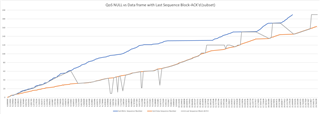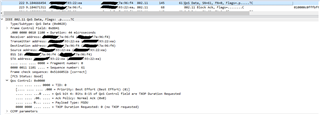Part Number: WILINK8-WIFI
We have identified a compatibility issue between the newer Samsung S7 tablets and the WL8 running the latest firmware (8.9.0.0.90) when the WiLink8 is acting as an AP with WMM enabled
The tablet is sending QoS data frames of type 0x0028 as expected, but is also sending QoS NULL frames of type 0x002c and is using independent Sequence Number chains for those two types of packets.
When the two sequence number chains get close to each other with Block ACK enabled, the Block ACKs being sent by the WiLink8 get confused and start getting sent with Block-ACK bitmap values from the QoS NULL chain, but on the Block-ACKs for the QoS Data frames. This effectively black-holes sequence numbers in the hole between the two chains resulting in the WL8 Block-ACKing incoming QoS Data frames, but not passing them up to the host for processing, as it appears to think that it already did.
iOS tablets appear to use type 0x0024 (the non-QoS type) for their NULL frames and do not experience this problem.
I can provide several .pcap files showing this behavior if required.



